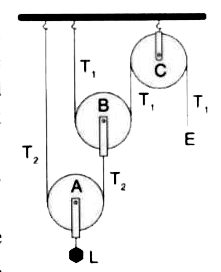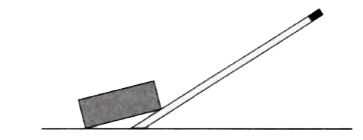State the class of levers and the relative positions of load (L), effort (E) and fulcrum (F) in each of the following cases.
(1) A bottle opener
(2) Sugar tongs.
To solve the question, we need to identify the class of levers for both a bottle opener and sugar tongs, along with the relative positions of the load (L), effort (E), and fulcrum (F) in each case.
1. Understanding the Classes of Levers:
- There are three classes of levers based on the relative positions of the load, effort, and fulcrum:
- Class 1 Lever: Fulcrum is between load and effort (L - F - E).
- Class 2 Lever: Load is between fulcrum and effort (F - L - E).
- Class 3 Lever: Effort is between load and fulcrum (F - E - L).
2. Analyzing the Bottle Opener:
- Position of Components:
- In a bottle opener, the fulcrum is at one end (the pivot point).
- The load (the bottle cap) is placed in the middle.
- The effort is applied at the opposite end (the handle).
- Relative Position: Fulcrum (F) - Load (L) - Effort (E).
- Class of Lever: Since the load is between the fulcrum and the effort, a bottle opener is classified as a Class 2 Lever.
3. Analyzing the Sugar Tongs:
- Position of Components:
- In sugar tongs, the fulcrum is located at the pivot point where the two arms of the tongs meet.
- The load (the sugar) is placed at the ends of the tongs.
- The effort is applied at the center of the tongs.
- Relative Position: Fulcrum (F) - Effort (E) - Load (L).
- Class of Lever: Since the effort is between the load and the fulcrum, sugar tongs are classified as a Class 3 Lever.
Final Answer:
1. Bottle Opener: Class 2 Lever (F - L - E)
2. Sugar Tongs: Class 3 Lever (F - E - L)
- There are three classes of levers based on the relative positions of the load, effort, and fulcrum:
- Class 1 Lever: Fulcrum is between load and effort (L - F - E).
- Class 2 Lever: Load is between fulcrum and effort (F - L - E).
- Class 3 Lever: Effort is between load and fulcrum (F - E - L).
- Position of Components:
- In a bottle opener, the fulcrum is at one end (the pivot point).
- The load (the bottle cap) is placed in the middle.
- The effort is applied at the opposite end (the handle).
- Relative Position: Fulcrum (F) - Load (L) - Effort (E).
- Class of Lever: Since the load is between the fulcrum and the effort, a bottle opener is classified as a Class 2 Lever.
- Position of Components:
- In sugar tongs, the fulcrum is located at the pivot point where the two arms of the tongs meet.
- The load (the sugar) is placed at the ends of the tongs.
- The effort is applied at the center of the tongs.
- Relative Position: Fulcrum (F) - Effort (E) - Load (L).
- Class of Lever: Since the effort is between the load and the fulcrum, sugar tongs are classified as a Class 3 Lever.
1. Bottle Opener: Class 2 Lever (F - L - E)
2. Sugar Tongs: Class 3 Lever (F - E - L)
Topper's Solved these Questions
Similar Questions
State the class of levers and the relative positions of load (L), effort (E) and fulcrum (F) in (a) a bottle opener, and (b0 sugar tongs.
View SolutionDescribe the three classes of levers with diagrams representing the positions of the effort, load, and fulcrum in each case.
View SolutionIndicate the positions of load L, effort E and fulcrum F in the forearm shown alongsind in figure. Name the class of leverl.
 .
.
View SolutionDraw diagrams to illustrate the positions of fulcrum, load and effort, in each of the following :
(a) A seesaw
(b) A common balance
(c) A nut cracker
(d) Forceps.
View Solution
The diagram alongside shows an arrangement of three pulleys A,B and C. the load is marked as L and the effort as E.
(a) Name the pulleys A,B and C.
(b) Mark in the diagram the directions of load (L), effort (E) and tension T1andT2 in the two strings.
(c) How are the magnitudes of L and E related to the tension T1 ?
(d) Calculate mechanical advantage and velocity ratio of the arrangement.
(e) What assumptions have you made in parts (c) and (d) ?
View SolutionIn Figure, draw a tackle to lift the load by applying the force in downward direction.
(a) Mark in the diagram the direction of load L and effort E.
(b) If the load is raised by 1 m, through what distance will the effot move ?
(c) State the number of strands of tackle supporting the load.
(d) What is the mechanical advantage of the system?

View SolutionDraw a simple diagram ofa fire tongs and mark on it the fulcrum F and the points of application of load L and effort E. (a) Name the class of lever. (b) if load arm is 15 cm and effort arm is 5 cm. what is its mechanical adavantage?
View SolutionThe diagram below shows a rod lifting a stone.
(a) Mark position of fulcrum F and draw arrows to show the directions of load L and effort E. (b) What class of lever is the rod ? (c) Give one more example of the same class of lever stated in part (b).
 .
.
View SolutionClassify the following into levers as class I, class II or class III:
(a) a door
(b) a catapult
(c) claw hammer
(d) a wheel barrow
(e) a fishing rod.
(f) sugar tongs.
View SolutionA lever of length 9 cm has its load arm 5 cm long and the effort arm is 9 cm long. (a) to which class does it belong ?
(b) Draw a diagram of the lever showing the position of the fulcrum F and directions of both the load L and effort E. (c) what is the mechanical advantage and velocity ratio if the efficiency is 100%?
(d) What will be the mechanical advantage and velocity ratio if the efficiency becomes 50%?
View Solution